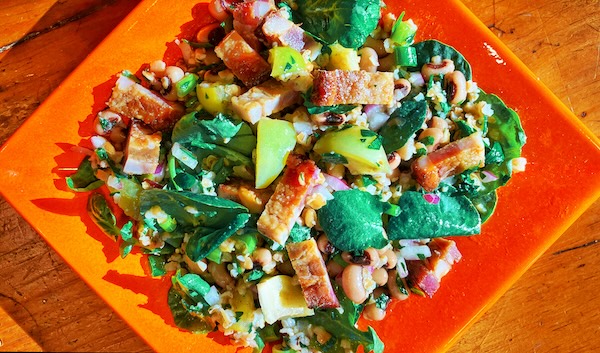Nobody wants to cook in the dog days of summer but thank God it’s also the height of harvest season and the best time to scour markets for what’s freshest and needs the least kitchen time. Salads fit the bill.
Chef Michael Solomonov’s watercress and walnut tabbouleh caught my attention by foregrounding watercress. It’s usually hard to find but surprisingly still available at Adams and Nature’s Pantry. I was inspired to pair it in an uncommon take on traditional tabbouleh.
When I found a half bag of Rancho Gordo’s Super Lucky black-eyed peas left over from the New Year’s Hoppin’ John, Sean Brock’s black-eyed pea and watercress salad suggested another angle.
A mash-up came into view.
Brock suggests pickled green tomatoes to brighten the flavors, but because I couldn’t find any at the markets, I settled on tomatillos. This proved to be the right choice; even pickled for a couple of days, they provided a needed crunch. A pan-Southern theme was beginning to emerge, so a dressing of apple cider vinegar, maple syrup, lemon and olive oil made sense.
When it comes to some-of-this and some-of-that recipe development, it’s never done until it’s overdone: In thinking on that Hoppin’ John, I added a garnish of maple syrup-lacquered bacon “batons,” or lardon, because, well — pork! (Optional for vegetarians, of course.)
Notes on Prep and Substitutions
Given the rash of 100-degree-plus heat index days, which no doubt will return, cook your beans early in the morning. You can substitute canned peas, but cooking your own allows you to control the amount of “bite” they deliver. The canned variety are usually too soft for cold salads.
The lardons are another early morning chore. You’ll need two slices of thick cut (¼ inch) smoked, cured bacon. Heat the oven to 375 degrees. Mix ¼ cup maple syrup, ½ teaspoon hot sauce and 1 teaspoon brown sugar in a small bowl. Place the slices on a greased wire rack over a foil-lined, greased sheet pan. Brush with the maple glaze. Bake for 20 minutes.
Remove from the oven, flip the strips over and glaze again. Return to the oven, baking for another 15 to 20 minutes. When done, cool and cut the strips into ¼-inch batons. (I suggest doubling or tripling the order and saving the extra batons for other salads.)
The bulgur isn’t a problem: You’re soaking the grain, and an electric kettle makes short work of boiling water.
Pickles don’t require cooking beyond a warm brine, but they do “pickle” for at least one day, better if two. Consider making more — they’re useful for a variety of other cold salads (potato, egg, chicken) or sandwiches and will keep refrigerated for a month or more. If you can’t find watercress, baby arugula will do in a pinch.

Black-Eyed Pea & Watercress Tabbouleh with Pickled Tomatillos
For the pickled tomatillos
Prepare at least one and preferably two days ahead.
- 1 one-pint Ball jar with lid, sterilized in boiling water
- ½ teaspoon peppercorns
- ½ teaspoon yellow mustard seeds
- ¼ teaspoon red pepper flakes
- 1 clove garlic, smashed
- 4 to 5 medium tomatillos, husked, cut into eighths, then halved
- ½ cup cider vinegar
- ½ cup water
- 1 teaspoon kosher salt
- 1 teaspoon raw cane sugar
1. Place peppercorns, mustard seeds, pepper flakes and garlic in jar and top with tomatillos. In a small saucepan, combine water, vinegar, salt, sugar and salt. Set over medium-high heat; bring to a low boil and remove from heat. Swirl the pan to dissolve sugar and salt and pour over the tomatillos. Cool to room temperature uncovered; cap the jar and refrigerate overnight or, better, two days. Will keep covered and refrigerated for up to two months.
For the tabbouleh
- ¾ cup dried black-eyed peas (to make about 2 cups cooked) or canned, drained peas
- ¾ cup bulgur wheat (about 2 cups total prepared)
- 1 cup (or more) flat-leaf parsley leaves, chopped fine
- ½ medium red onion, diced small
- 3 to 4 ounces watercress, stems removed, plus more for serving
- 1 cup pickled tomatillos (chop half into a smaller dice)
- Optional: Maple syrup-lacquered lardons (see note)
For the vinaigrette
- 1 tablespoon Dijon mustard
- 1 tablespoon apple cider vinegar
- Zest and juice of 1 lemon
- ½ tablespoon hot sauce, or to taste
- ½ tablespoon maple syrup
- ¼ cup extra-virgin olive oil
- 1 tablespoon chopped fresh oregano
- 1 tablespoon chopped fresh thyme
1. In a 2-quart pot, cover peas with water plus 3 inches; bring to a low boil for 10 minutes. Reduce heat to a steady light simmer. Cook for 30 minutes to 1 hour, checking often. You don’t want mushy beans, but beans with a little bite. When done, drain and rinse with cold water to stop cooking.
2. In a bowl, cover the raw bulgur with 2 cups boiling water and soak for an hour. Drain and cool to room temperature.
3. While the beans cook and the bulgur soaks, prepare the vinaigrette: in a small bowl or measuring cup, whisk all the ingredients till smooth and reserve.
4. Mix the cooled, drained beans, bulgur and red onions in a large bowl. Toss with about half the vinaigrette. Adjust seasoning to taste with salt and pepper; add the parsley, watercress and pickled tomatillos. Toss lightly to combine, adding more vinaigrette if needed. Chill for up to an hour to let the flavors meld. Serve over more cress or other greens. Garnish with lardons if using. Pass more vinaigrettes at the table.

